How the Viking got his Horns
based on Malcolm Hill’s A Viking in Novgorod
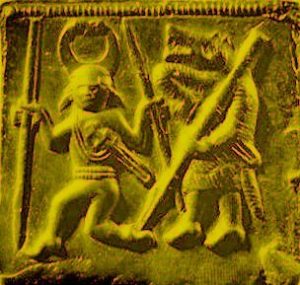
A brief comedy-opera
by
Malcolm Hill
How the Viking got his Horns was composed to act as a curtain-raiser to Women on Top (based on Aristophanes’ Assembly Women), and is positioned mid-way between the present and Women on Top.
It was written for the same cast, with the addition of a Narrator and Greek Chorus who comment on the proceedings.
It takes place soon after the Vikings have arrived in Novgorod, and deals with the implications of the stamp-mould above (which inspired the work).
How the Viking got his Horns is a tale of medieval shamans and shapeshifting set in a medical centre in Novgorod where Western medicine is considered as ‘alternative’.
A nervous Viking trader and his no-nonsense wife have just arrived in Russia. To relieve his shape-shifting symptoms, they see a young locum, a shaman and a psychiatrist.
The cast for the first performance on 11th February 2015 at 7.30 at the Rondo Theatre, Bath, was:
| Jane Hunt | The shaman head of the medical centre |
| Julia Rushworth | Strong-willed wife of the Viking |
| Rob Jack | A locum and arrogant medic |
| Simon Caldwell | A kind and knowledgeable medic |
| Paul Feldwick | A Viking with many problems |
| Susanna Watson | Narrator |
| Members of Chandos Singers | Greek Chorus |
| Malcolm Hill | Director |
The opera opens with a young medical locum waiting for his next patient in the 9th century Novgorod Medical Centre.
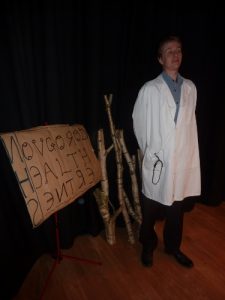
The Centre, where a few foreign medics have been brought in to work as ‘alternative therapists’, is run by a shaman – Christianity has yet to arrive in Novgorod. While the Vikings were famous for rape and pillage in Western Europe (getting as close as establishing a base in Chippenham in the 870’s), they also worked as traders in the lands east of Scandinavia. The Narrator and Chorus sing alliterative verse honouring the North European tradition. Their function is, like a Greek chorus, to comment on the proceedings as well as to set the scenes.
A Viking trader
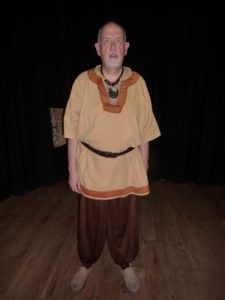
and his wife

enter, she lists his problems and presents the locum with a picture of his symptoms.

He merely glances at the picture, sings, ‘No problem, I’ve just been on a one-day course, so I’m sure I can help’, then ousts the Viking’s wife. The locum tries to get the Viking to relax and when the Viking starts to explain what creates his problems the locum gets irritated. The lack of good communication between them leads to one of the Viking’s symptoms appearing.
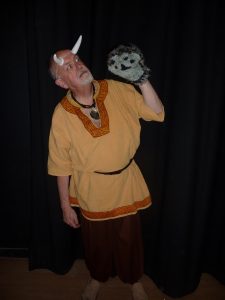
This scares the locum who immediately dismisses the Viking with “Come back in six months if the problem persists – goodbye.”
“Wait six months?!!” fumes the angry wife.
They return to see the Centre’s director, Shameness Sidorova.
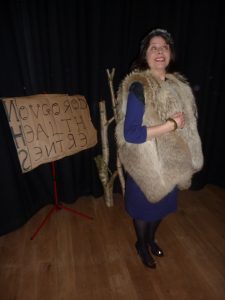
Symptoms are again listed and the husband refuses to demonstrate his problems. The Shameness announces that treatment will depend on whether they were caused by the Gods, by his enemies, by mistake for someone else, or by “life-style choices”. She then starts an intricate incantation over the Viking, assisted by his wife.
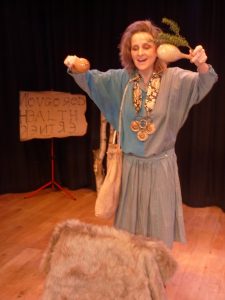
Exhausted, the Shameness announces that if his problems had been caused by enemies or by mistake they will not recur. She explains what to do if they were caused by the Gods. “If caused by yourself, come back to us; here’s a leaflet, goodbye.”
A warm and sympathetic “alternative but dyslexic psychiatrist”

is given the medical picture by the Viking’s wife,
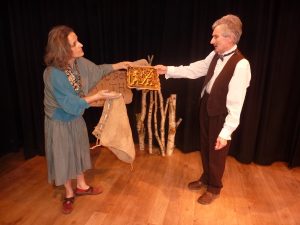
he looks at it,
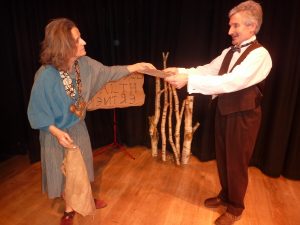
then puts the Viking at his ease and is obviously interested in his patient. Asked to describe when he was last happy, the Viking recounts his idyllic childhood on the farm, then how his world changed when he was sent away to rape-and-pillage school – he never enjoyed being a warrior and jumped at the chance to become a trader. The psychiatrist gently explains his diagnosis and the Viking realises that he is cured. Now that the Viking will no longer need the picture of his symptoms, the psychiatrist asks if he may make copies for an article in the next Lance-and-Pack-it. From this leading medical journal, the article will soon be badly translated into many languages. Likenesses of the picture will be re-created as moulds, amulets and statues. In time these will be considered examples of normal Viking wear. And so was born the myth that Viking helmets had horns.
Bath Chamber Opera also performed excerpts from How the Viking got his Horns in Bath’s Party-in-the-City on Friday 15th May 2015 at 7.30pm in Bath Central United Reformed Church.
